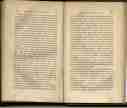Robert Burns's Appearance

The Painting by Alexander Nasmyth, 1787 Scottish National Portrait Gallery)
We all probably have the same images in our minds of Burns's appearance that we have seen in the few paintings and sketches of him that are available. The one above was painted by Alexander Nasmyth when Burns was 28 years old but Nasmyth was actually a landscape painter. We don't know how good he was at portraits but we can probably accept that this is a reasonable likeness
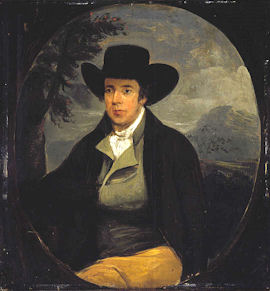
Robert Burns from Original Portrait by Peter Taylor
There is a school of thought that the image painted by Peter Taylor (above) may be the closest likeness. Painted in 1786, this was the earliest recorded image of Burns. Taylor was an Edinburgh house and coach painter but apparently Burns did actually sit for him while on one of his visits to the city. The fact that Taylor was not an artist per se and that I have been unable to find any other examples of his paintings suggest that he was not prolific and that his skill as a portrait painter may be in doubt.
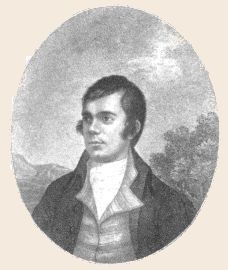
The image above is from an engraving by John Beugo in February 1787. Beugo was a friend of Burns and since it was done in Burns's lifetime by someone who knew him well it is likely that this is the best likeness. The image was based on Nasmyth's portrait but clearly he had every opportunity to modify this and to ensure that he had a good likeness. This image was commissioned for the publication of Burns's Poems, Chiefly in the Scottish Dialect, published by William Creech that year.
It is said that Burns was very pleased with the print and that he wrote to Beugo to congratulate him on it. In a copy of the book given to a friend he wrote the following lines.
I send you a trifle, a head of a Bard
A trifle not worthy your care;
But accept it, good sir, as a mark of regard
Sincere as a Saint's dying prayer.
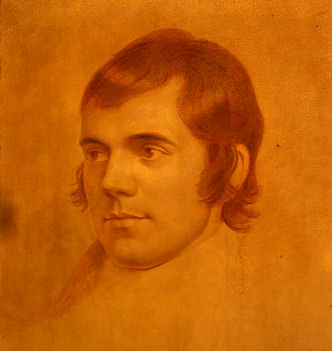
The logo on the top right hand side of the pages on this site is from the sketch (above) made in 1798 by Archibald Skirving who never actually met Burns. Apparently he made the sketch from a another picture but apart from being a nice image it bears a striking resemblance to Nasmyth's version of Burns so it could also be fairly accurate.
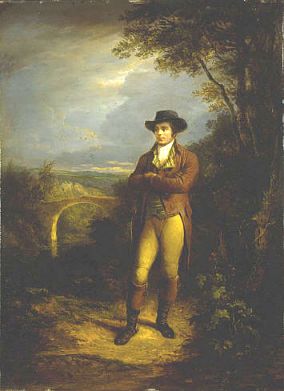
Alexander Nasmyth also painted the picture above in 1828, more than thirty years after the poet's death.
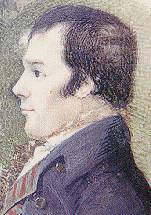
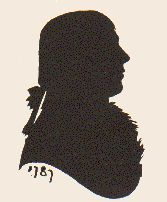 The image on the left is held in Dumfries
museum. It was painted by a local miniaturist, Alexander Reid.
Once again we have no way way of knowing how accurate it is.
The poet is depicted as being a bit heavier in this
image, which is strange since it was reportedly done in January 1796 when
he was already quite ill and only six months before his death. Surprisingly, Basil Skinner's 1963 book suggests that Burns himself thought this was the best likeness.
The image on the left is held in Dumfries
museum. It was painted by a local miniaturist, Alexander Reid.
Once again we have no way way of knowing how accurate it is.
The poet is depicted as being a bit heavier in this
image, which is strange since it was reportedly done in January 1796 when
he was already quite ill and only six months before his death. Surprisingly, Basil Skinner's 1963 book suggests that Burns himself thought this was the best likeness.
The Reid Miniature can be dated precisely by two references in Burns's letters, the first already quoted, writing to George Thomson in May1795 and the second in a letter of January 1796 to Mrs Walter Riddell - 'Apropos pictures, I am now sitting to Reid in this town for a miniature, and I think he has hit the best likeness of me ever taken'.
The silhouette above was done by John Miers in 1787. It is said to be reasonably accurate but it is of limited value in determining Burns' likeness because of the obvious limitations of silhouettes.
 The Reid miniature and the the Miers silhouette are the only images of Burns from a side view. I tested them by enlarging Miers silhouette and reversing it so that it is on the same perspective and a similar size to Reid's image. While Miers's is only a silhouette and the hair styles are different some similarities can be seen.
The Reid miniature and the the Miers silhouette are the only images of Burns from a side view. I tested them by enlarging Miers silhouette and reversing it so that it is on the same perspective and a similar size to Reid's image. While Miers's is only a silhouette and the hair styles are different some similarities can be seen.
These then are the sources of all subsequent paintings (and probably sculptures) of Burns.
We also have a written description of Burns. In volume one of the "Works of Robert Burns" from 1834. Allan Cunningham wrote;
"Burns in his youth was, was tall and sinewy, with coarse swarthy features, and a ready word of wit or of kindness for all. The man differed little from the lad; his form was vigourous, his limbs shapely, his knees firmly knit, his arms muscular and round, his hands large, his fingers long and he stood five feet ten inches high."
Click the image below to display a full copy of the description of Robert Burns's physical appearance from Cunningham's book.
Bryan Weir December 2006
To a large extent this description is unsafe. Allan Cunningham was a generation younger than Burns and only a wee boy at the time, but he claims to remember the bard. Cunningham's father was Burns' Neighbour at Ellisland farm but Burns was only at Ellisland farm for around three years from 1788 to 1791, so the description is suspiciously detailed when we consider that it was written by someone who was only three to six years old when he knew the poet.
Update May 2013
Some of you will have read the publicity about the reconstruction of Burns' image by forensic experts at Dundee University. You may also have watched the STV documentary by David Hayman, which was broadcast in January this year. Personally I think the jury is still out. It looks to me as though the image has been based more on already existing imagery of Burns than on any valid scientific process. Also, it must be said that this chap is no Brad Pitt,

So Burns in this version is not the handsome chap that so many women seemed to find irresistible. The technique used in these reconstructions is a wee bit shaky. They have no way of knowing any of the fine details of the face where no tissue remains. In my opinion much of it is guesswork.
They can obviously calculate the correct distance between the eyes, nose and mouth from the skull but how do they know how bushy the eyebrows were? If there is no soft tissue how can they tell how fat or thin the person was? How do they know what shape of nose and mouth and how much hair he had? While the attempted reconstruction is to be commended I'm not sure that it has any real value. But then it made interesting TV and kept the bard in the public eye.

